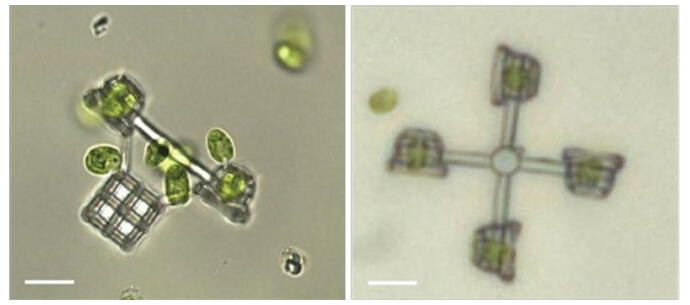A research group led by Professor Shoji Takeuchi, Project Research Associate Haruka Oda, and Naoto Shimizu (a graduate student at the time of the study) of the Graduate School of Information Science and Technology at the University of Tokyo has announced that they developed a method to drive small structures using the microalga Chlamydomonas reinhardtii. They devised a trap structure that does not interfere with the movement of the flagella of C. reinhardtii, which is known for its exceptional propelling force among microorganisms. Their method allowed the incorporation of the organisms into various microstructures and is expected to find application as a tool for driving microrobots and understanding microorganism movement. The results were published in the international journal Small on July 8.

Provided by the University of Tokyo
Micromachines are expected to be useful in areas such as investigating and removing contaminants in the environment and transporting materials in microenvironments, but on the other hand, their small size precludes the use of batteries or motors. As the material size decreases, the viscosity increases to an extent where it is a dominant factor during the transportation of the material, and efficient transportation becomes more difficult.
To address these issues, the group examined the use of the propelling force of C. reinhardtii. This algae swims by moving its two flagella in a similar pattern to a breaststroke swimmer. Therefore, they devised a "cage-like" trap structure to interfere with this movement as minimally as possible. Using an ultra-precise stereolithography three-dimensional printer, the group fabricated a structure similar in size to a C. reinhardtii organism and confirmed that because the trap structure has many gaps, the flagella can move outside of it, and the position of the algae can be arranged in a variety of shapes.
Two types of micromachines were produced: one with four algae arranged in a circular configuration and the other with two facing the same direction. As a result, they observed that the micromachines with the circular arrangement rotated and maintained a stable attitude. They also found that the rotational velocity changed depending on the number of C. reinhardtii organisms. These methods are expected to find application in environmental monitoring in aqueous environments, as well as in phototaxis-based machinery for substance transport, power transmission, and other purposes.
Takeuchi said, "This study began when Mr. Naoto Shimizu, a master's student at the time, proposed a micromachine that works with C. reinhardtii organisms. Initially, it seemed difficult to achieve, but Mr. Shimizu put effort into the study with conviction and succeeded after about 6 months. This was the result of examining various conditions, including the size and height of the cups and the concentration of algae, and the process is summarized in this paper."
"Although this research project is still in a basic stage, our method will likely be useful as a biophysical tool to study how multiple C. reinhardtii organisms move under physical constraints and expand and analyze their movements without chemical modifications to them. Moving forward, we believe such a complex mechanism could be installed in a pond containing many algae to regulate their movement for producing energy."
Journal Information
Publication: Small
Title: Harnessing the Propulsive Force of Microalgae with Microtrap to Drive Micromachines
DOI: 10.1002/smll.202402923
This article has been translated by JST with permission from The Science News Ltd. (https://sci-news.co.jp/). Unauthorized reproduction of the article and photographs is prohibited.




